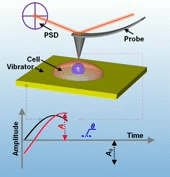

Cells, as the elementary units of living organisms, are regulated and governed by genes, biological processes and various microenvironments, and their status reflects the organism’s physiological situation and affects the biological function of the whole body. Moreover, recent studies have demonstrated that cells’ mechanical properties, such as cellular mass, elasticity, viscosity and resonant frequency, are closely related to their function, including migration, differentiation, malignancy, and death.
Recently, great progress has been achieved in the development of instruments and techniques to measure the mechanical properties of individual cells and cell populations and thereby contribute to the fields of cytology and medicine. However, there still exist some imperfections in the current measurement methods, such as low accuracy and throughput, restrictive requirements on operating environments, the requirements of sterility and biocompatibility of the measurement tools, and the capacity of simultaneously in situ obtaining multiple mechanical properties of living cells with one measurement system.
In this study, we proposed an indentation-vibration method based on the principle of forced vibration for in situ simultaneous measurement of multiple mechanical properties, including the mass, elasticity and viscosity, of cells using an AFM system integrated with a piezoelectric transducer as the substrate vibrator. A second-order mass-spring-damper harmonic oscillator system was used to model the dynamical forced vibration of a sample cell actuated by the substrate vibration. Living and fixed HEK 293 cells were used as the prototype samples for the measurement experiment to validate the proposed indentation-vibration-based method. Moreover, the scanning position on the cellular surface was evaluated to elucidate how varying the measurement position altered the measured mechanical properties of a single cell. This study should contribute to progress in biomedical engineering, cytobiology, medicine, early diagnosis, specific therapy and cell-powered robots. More details about this work can be found in the article.

